Esther Murphy Strachey
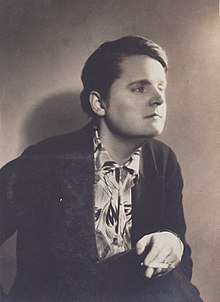
Esther Murphy (October 22, 1897 – November 23, 1962) was a New York intellectual, historian, conversationalist and socialite.
Biography
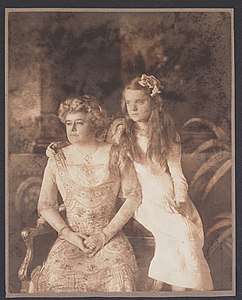
Esther Murphy was born on October 22, 1897, the daughter of Patrick Francis Murphy (1858–1931), owner of the Mark Cross Company, sellers of fine leather goods, and Anna Elizabeth Ryan (c. 1858–1932). She had two siblings: Gerald Clery Murphy (1888–1964) and Frederic Timothy Murphy (1884–1924).[1]
Unable to attend Bryn Mawr College due to her mother's health, Murphy followed the Harvard University curriculum at home.[2]
She frequented a circle of American expats living in the French Riviera in the 1920s. A 1926 letter written from France by F. Scott Fitzgerald noted, "Nobody was in Antibes that summer... except me, Zelda, the Valentinos, the Murphys, Mistinguett, Rex Ingram, Dos Passos, Alice Terry, the MacLeishes, Charlie Brackett, Maud Kahn (daughter of philanthropist Otto Kahn; wife of Major-General Sir John Marriott), Esther Murphy (sister of Gerald; wife of John Strachey), Marguerite Namara, E. Oppenheimer (sic), Mannes the violinist, Floyd Dell, Max and Crystal Eastman, ex-premier Orlando, Etienne de Beaumont... Just the right place to rough it, an escape from the world."[3][4]
When in Paris, she frequented Janet Flanner (who would later became a lover of her sister-in-love, Noël Haskins Murphy) and Solita Solano, Gertrude Stein and Alice B. Toklas, Dolly Wilde and Natalie Clifford Barney (who was Murphy's passionate obsession).[2]
In 1928 Djuna Barnes wrote a satirical group biography of Natalie Clifford Barney's Parisian circle, the Ladies Almanack (1928), in which Murphy's caricature is "Bounding Bess." Murphy in turn wrote a fantasia that metamorphoses Barney into a 13th-century abbess also known for "amazing activities during the Crusades."[5] Indeed, in a story recounted by Murphy, Isabel Pell, with Barney, really infiltrated a 13th-century Italian convent to meet with Alice Robinson, one of Barney's affairs.[6]
Murphy was also friends with Mercedes de Acosta, Madge Garland, Edmund Wilson and Dorothy Parker.[2][5] Another friend, novelist Dawn Powell wrote about what she perceived as Murphy's failure of a life: "Some people don't want to be the action – they really want to be spectator."[2]
She published essays and books, was a public speaker, and was a regular panelist along with Eleanor Roosevelt, Margaret Mead, and Fanny Hurst on the ABC radio program Listen – The Women!.[2]
On April 29, 1929, Murphy married John Strachey, British Labour politician and writer.[7] Oswald Mosley was the best man at the wedding.[8]
In 1935 Murphy married Gavin Arthur, a San Francisco astrologer and sexologist and a grandson of American President Chester A. Arthur. He was also an early gay rights activist and a practical prototype for the hippies. They divorced in 1961.[9]
In 1945 she met writer Sybille Bedford, who would became her lover; the relationship lasted only a few years, but they remained lifelong friends.[2]
Esther Murphy died on November 23, 1962, in Paris. Her ashes were returned to the United States on December 5, 1962 to her brother, Gerald Murphy.
Gallery
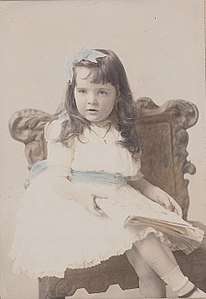 Esther Murphy as a young girl, by George Gardner Rockwood (1832-1911), between 1907 and 1910
Esther Murphy as a young girl, by George Gardner Rockwood (1832-1911), between 1907 and 1910 Esther Murphy Arthur as a girl with actor John Drew Jr., between 1910 and 1915
Esther Murphy Arthur as a girl with actor John Drew Jr., between 1910 and 1915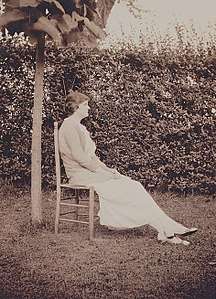 Esther Murphy Arthur sitting outside on a chair, 1923
Esther Murphy Arthur sitting outside on a chair, 1923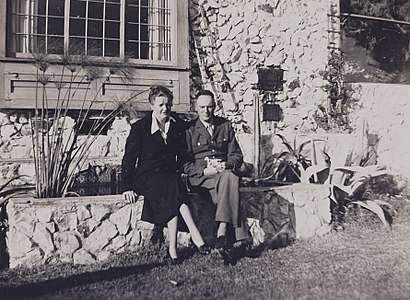 Chester Arthur III (Gavin Arthur), in uniform, and Esther Arthur sitting on a rock wall, 1942
Chester Arthur III (Gavin Arthur), in uniform, and Esther Arthur sitting on a rock wall, 1942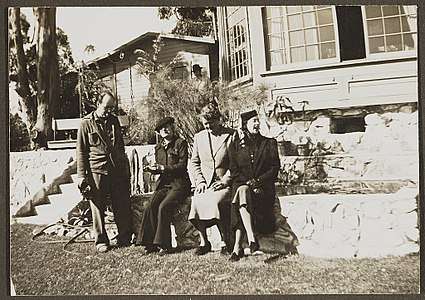 Gavin Arthur, standing, and Janet Flanner, Esther Murphy, and Solita Solano sitting on a rock wall, between 1945 and 1955
Gavin Arthur, standing, and Janet Flanner, Esther Murphy, and Solita Solano sitting on a rock wall, between 1945 and 1955
Legacy
Lisa Cohen, All We Know: Three Lives (Farrar, Straus and Giroux; First Edition (July 17, 2012)) is the biography of three women: Esther Murphy, detailing early Murphy life and the Mark Cross family business; writer-feminist Mercedes de Acosta; and British Vogue fashion editor Madge Garland. Cohen was intrigued by their invisibility: "if she is remembered at all today, it is as Gerald Murphy's eccentric, pathetic sister, a marvel who became a spectacular disappointment."[2]
References
- ↑ "Guide to the Sara and Gerald Murphy Papers YCAL MSS 468". Beinecke Rare Book and Manuscript Library. Retrieved 7 January 2018.
- 1 2 3 4 5 6 7 "Eluding Magnificent Monuments: The Stylish Lives of Esther Murphy, Mercedes de Acosta, and Madge Garland". bookslut. Retrieved 11 January 2018.
- ↑ Website for Antibes
- ↑ Website for Juan Les Pins Archived 2007-06-07 at the Wayback Machine.
- 1 2 Booth, Alison (2013). "Books Full of Women". Retrieved 11 January 2018.
- ↑ Cohen, Lisa (2012). All We Know: Three Lives. Farrar, Straus and Giroux. p. 75. Retrieved 1 August 2017.
- ↑ Matthew (editor), Colin (2004). Dictionary of National Biography. 52. Oxford: Oxford University Press. ISBN 978-0198614111, essay on Strachey written by Michael Newman, pp1004-6
- ↑ M. Newman: Strachey, (Evelyn) John St Loe (1901–1963), socialist theorist and politician. Oxford Dictionary of National Biography. Retrieved 11 January 2018 http://www.oxforddnb.com/view/10.1093/ref:odnb/9780198614128.001.0001/odnb-9780198614128-e-36337.
- ↑ "Arthur Family Papers" (PDF). Library of Congress. pp. 3–4.